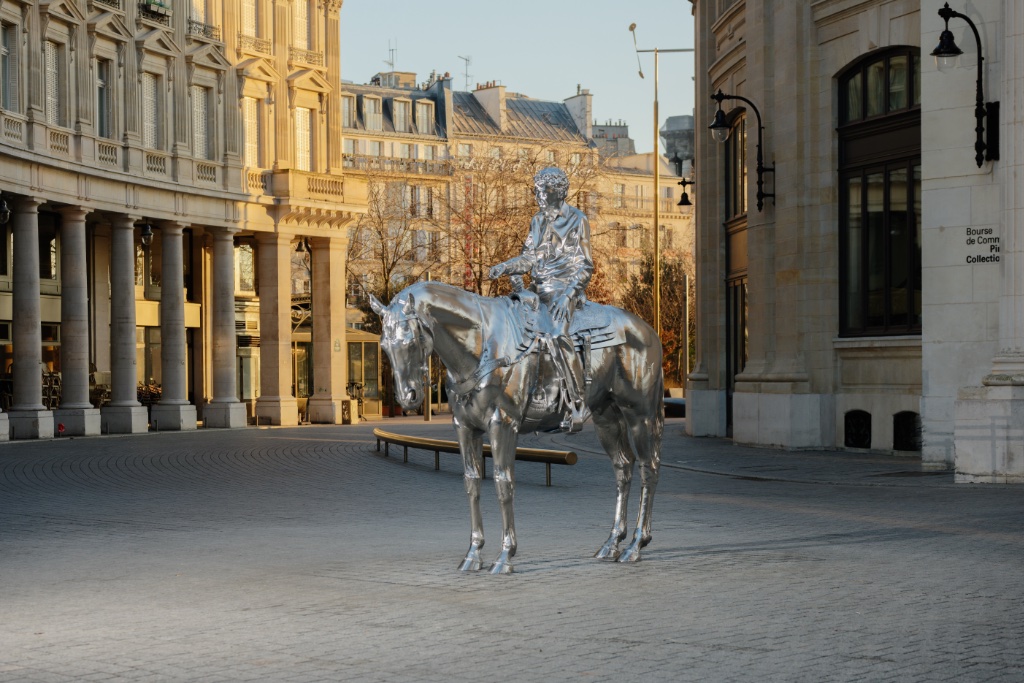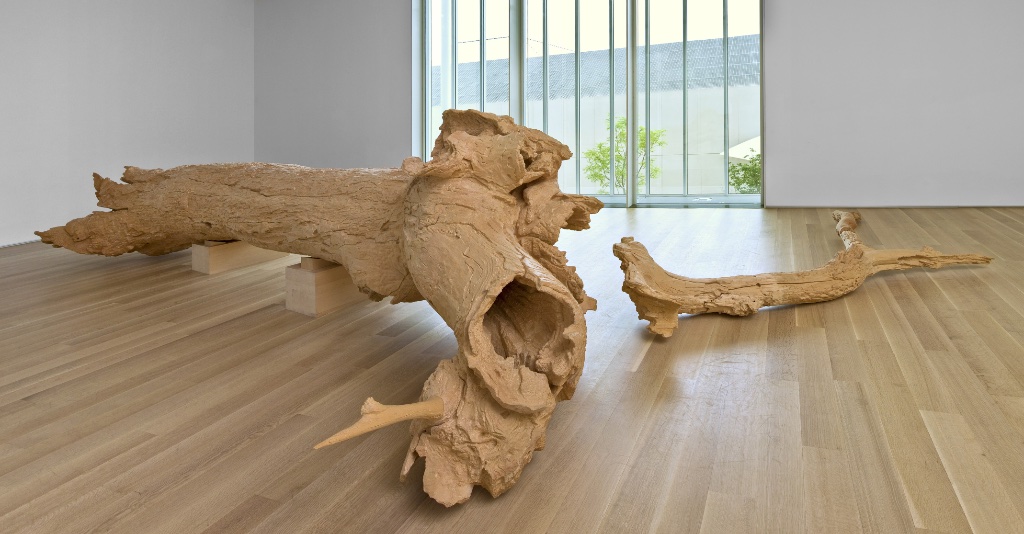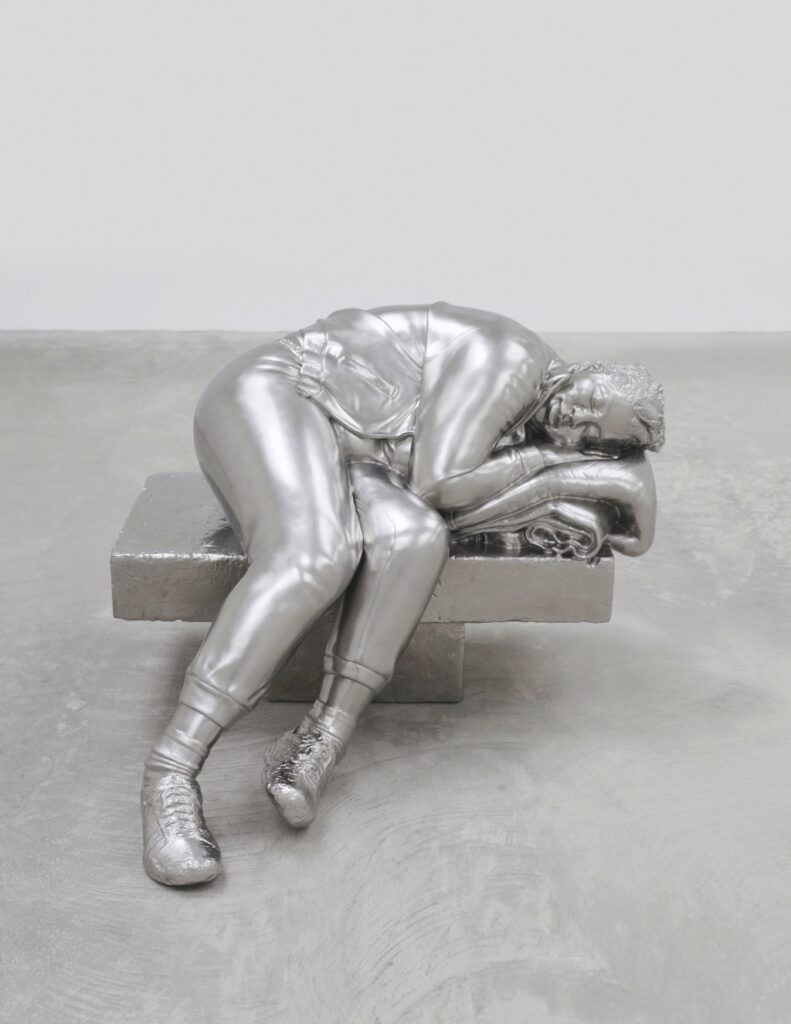
A major event of the current Paris art season is the double exhibition of the work of American sculptor and erstwhile photographer Charles Ray at the Centre Pompidou and the Bourse de Commerce–Fondation François Pinault.
One wonderful thing about his work is that it varies so much. At the press opening of the Pompidou exhibition, he said, “I never think about sculpture; I think sculpturally.” That helps to explain how disparate his works are, ranging from photographs (a form he no longer uses) to shiny stainless steel sculptures, oversized statues of people and reconstituted vehicles and tree trunks.

What holds them all together? Ray’s wry sense of humor (and occasionally pathos), his repeated use of himself as the model for many of the works, and the sometimes mind-boggling amount of labor that goes into each piece. One example is “Hinoki” (2007), a cypress wood re-creation of a beautiful decaying tree trunk Ray spotted in a California field. He brought it to his studio and made a fiberglass version of it, which was sent to master woodworkers in Japan who specialize in re-creating wood structures or statues that can no longer be restored. The project, which took years to complete, preserved the trunk at one moment in time, but the sculpture itself will begin to decay in four hundred years or so.
Each work makes you wonder what he will think of next. At Pompidou, we first meet a mannequin of the young Ray, who was born in 1953, in the life-sized, clothed “Self-Portrait.” In those days, nothing said “nerdy “more than a (now-trendy) bucket hat. Many of his sculptures of people resemble store mannequins, with their dead, staring eyes, apparently a consequence of his having once worked in a department store.
Then we encounter the slyly titled “Portrait of the Artist’s Mother” (2021). Ray compares this Pop-influenced work to “an ancient painted Greek sculpture.” The oversized, brilliant-white sculpture of a naked reclining woman with her hand on her crotch, who may or may not be masturbating, is made of paper handmade in Ray’s studio and decorated with colorful stylized flowers. Aside from the title, there is absolutely no relation to the famous, highly realistic painting “Whistler’s Mother,” all in black, gray and white (currently on show in a small exhibition of Whistler’s work at the Musée d’Orsay).
Ray also attacks the sanctity of the family in “Family Romance” (1993), showing four naked members of a nuclear family holding hands. It takes a minute to realize what is so weird about this lineup: each person is the same height. The mother and father have been reduced in size and the two children grown taller to measure up to their parents.

Over at the Bourse de Commerce, more of Ray’s works, each one fascinating in its own way, are beautifully displayed in the rotunda and the light-filled second-floor galleries.
Another great example of the artist using himself as a model can be found in an X-rated sculpted group hidden away in a room by itself with a warning that it may disturb some visitors. At first glance, it seems to be a very explicit and rather creepy depiction of an orgy involving eight realistically portrayed naked young men, complete with real hair on their heads and, ahem, elsewhere.
On closer inspection, however, you realize that each of the mannequins (those dead eyes again) is the same – the young Charles Ray – and that none of them is actually touching another. Ray, who apparently made this piece, called “Oh! Charley, Charley, Charley…” (1992), after having his heart broken, is commenting here on the futility of love. He says of this complex work: “A sense of loneliness rather than sex is activated…. One’s lover is simply a projection of oneself.”

The three-ton stainless steel sculpture “Sleeping Woman” (2012), depicting a homeless woman napping on a bench in the street, is something else entirely. By immortalizing her in a monumental form usually reserved for heroes, Ray “endows her with majesty and dignity,” says curator Caroline Bourgeois.
As there is a story behind every one of these works, with references to current events, art history, literature or Ray’s own life, it really helps to read the wall texts or listen to Ray’s sometimes cryptic but always fascinating comments (on a podcast called Les Visites du Centre Pompidou or on the audioguide at the Bourse de Commerce). While his sculptures are wonderful to look at, they are even more entertaining and comprehensible when you hear what he and others have to say about them. It’s almost as if he is giving form to his thought processes.
Favorite